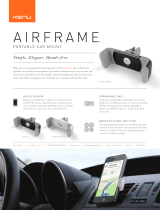ARTEX PRODUCTS / ACR ELECTRONICS, INC.
DESCRIPTION, OPERATION, INSTALLATION AND MAINTENANCE MANUAL
ELT 345 (P/N: A3-06-2880)
Y1-03-0282 Rev. M Company Confidential 25-62-35 Page 4 of 59
C. Other Countries ................................................................................................................. 24
2. Inspection and Test Procedures .................................................................................................. 25
A. Checklist ........................................................................................................................... 25
B. Preparation ....................................................................................................................... 25
C. Coax Cable and Wiring Connections Inspection – Item 1 ....................................................... 25
D. Mounting Tray and Hardware Inspection – Item 2 ................................................................ 26
E. Battery Pack Inspection – Item 3 ........................................................................................ 26
F. G-Switch Functional Check – Item 4 .................................................................................... 26
G. Performance Test Setup ..................................................................................................... 27
H. 121.5 MHz Frequency Measurement and Audio Modulation Check– Items 5a and 5b ............... 27
I. 121.5 MHz Power Output Measurement – Item 5c ................................................................ 28
J. 406 MHz Frequency Measurement – Item 5d ....................................................................... 28
K. 406 MHz Power Output Measurement – Item 5e ................................................................... 28
L. Current Draw Test – Item 5f ............................................................................................... 28
M. Digital Message Verification – Item 5g ................................................................................. 29
N. ELT Reset Check – Item 5h ................................................................................................ 30
O. Installed Transmitter / Antenna Test – Item 6 ...................................................................... 30
P. Antenna Test – Item 7 ....................................................................................................... 31
Q. Inspection and Test Documentation – Item 8 ....................................................................... 31
3. Fault Isolation ........................................................................................................................... 31
A. Self-Test ........................................................................................................................... 31
B. Troubleshooting ................................................................................................................ 33
REMOVAL ............................................................................................................................................ 34
1. ELT .......................................................................................................................................... 34
A. ELT Removal ..................................................................................................................... 34
2. Battery ..................................................................................................................................... 35
A. Battery Removal ................................................................................................................ 35
3. Material or Equipment Return ..................................................................................................... 36
A. Shipment Information ........................................................................................................ 36
B. Return Material Authorization .............................................................................................. 36
INSTALLATION .................................................................................................................................... 37
1. Regulatory Requirements and Guidelines ..................................................................................... 37
A. For US Registered aircraft: ................................................................................................. 37
B. TSO C126b, Paragraph D .................................................................................................... 37
C. FAA .................................................................................................................................. 37
D. Canada ............................................................................................................................. 37
E. Other Countries ................................................................................................................. 38
F. RTCA ................................................................................................................................ 38
2. Mounting Tray ........................................................................................................................... 39
A. Location ............................................................................................................................ 39
B. Installation ........................................................................................................................ 41
3. Antenna .................................................................................................................................... 42
A. General ............................................................................................................................. 42
B. Location ............................................................................................................................ 42
C. Installation General Info ..................................................................................................... 42
4. Remote Switch .......................................................................................................................... 43
A. Location ............................................................................................................................ 43
B. Installation ........................................................................................................................ 44
























